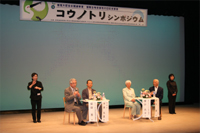Some time ago, Oriental White Storks disappeared from the sky above Japan. Hyogo Prefecture, the venue of the G8 Environment Ministers Meeting 2008, co-hosted the “Stork Symposium” in Toyooka in conjunction with the Tajima Executive Committee on projects related to the Environment Ministers Meeting, the Liaison Committee for the Reintroduction of the Oriental White Stork, the Hyogo Promotion & Cooperation Committee for the Environment Ministers Meeting, and the Ministry of the Environment. This Symposium was organized as a project related to the G8 Environment Ministers Meeting, which was convened from May 24 to May 26, 2008, and was also held on the International Day for Biological Diversity, 2008. Approximately 300 people attended the symposium.
- Lectures were given by the Director and by a researcher of the Museum of Nature and Human Activities, Hyogo. They defined biodiversity and clarified the importance of efforts towards biodiversity conservation by local communities.
- A popular Japanese photographer, famous for pictures mainly of Satoyama and insects, talked about his experiences while photographing. He also talked about the effects of environmental changes on wildlife and people’s livelihood.
- There was a report of activities about releasing storks into the wild and the conservation of salamanders from field practitioners in Toyooka City.
- A talk show was conducted regarding conservation of storks. During the show, the efforts towards environmental improvements, such as eco-friendly agriculture and river restoration, were recognized. Afterwards, continuous efforts toward future generations were called for.
For the program contents, click here.
 |
| Photo of Talk Show |
|
In addition to the symposium, “The Youth Summit for Environment in Kobe” was held on May 20 in conjunction with the G8 Environment Ministers Meeting. Eight children from seven different countries who participated in the Youth Summit visited Toyooka City. These children communicated with local high school students, and learned about the efforts of the local communities through participation in rice planting, also known as “a farming method for nurturing storks.” On May 23, some participants who joined the Environment Ministers Meeting visited the stork conservation site. |